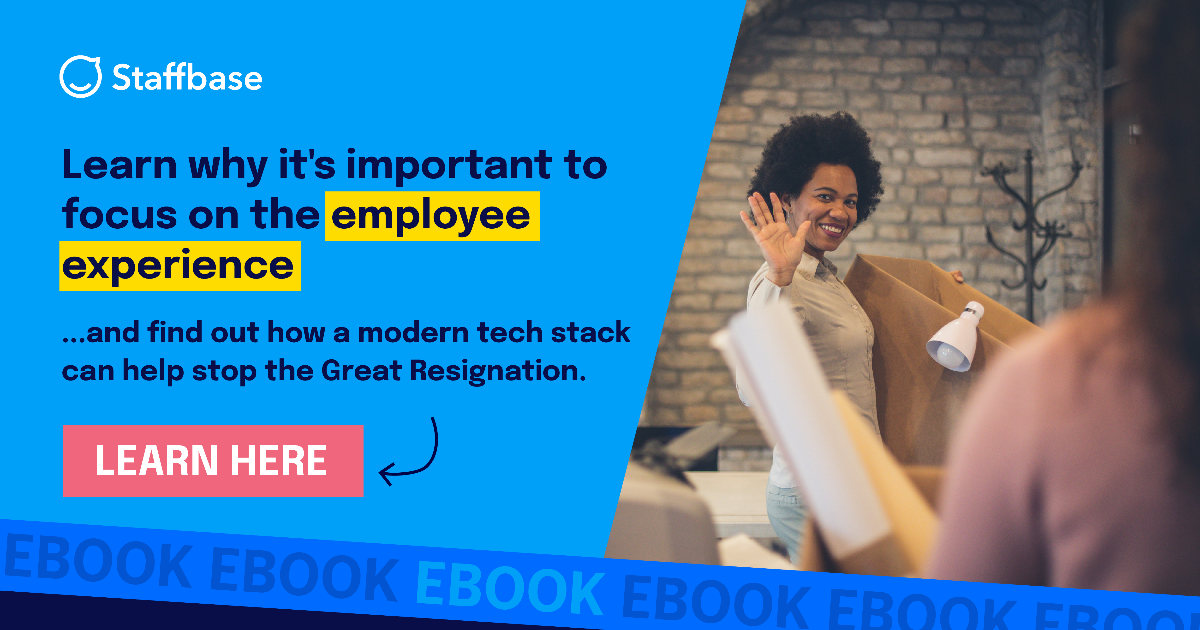Employee Experience Management: The Top 6 Goals and Examples
As work changes dramatically, employee experience professionals are leveraging internal comms and working across departments to ensure that work gets done right, and that its value is visible to all.

Employee experience management. We’ve written about it, we’ve defined it, and we continue to study it. In fact, we estimate that the number of Employee Experience jobs worldwide has increased several-fold since we first began looking at the trend in 2017, as businesses adapt to the evolving needs and expectations of their employees in a competitive job market.
For HR leaders, the whole topic of the employee experience has suddenly become a make or break issue.”
Josh Bersin
The new breed of employee experience manager plays a variety of corporate roles. And the rapid growth in their numbers is proof that EX — as an extension and a reappraisal of the traditional role of Human Resources — has become a key strategic business partner.
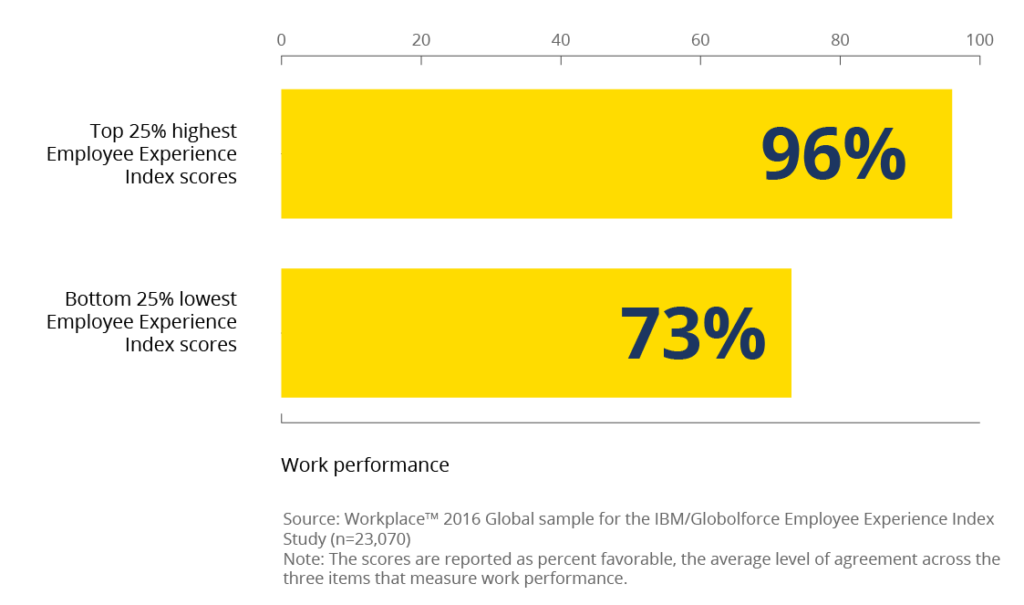 Positive employee experience is linked to better work performance.
Positive employee experience is linked to better work performance.
Equipped with people data, EX professionals are meeting the challenge of workforce administration by designing ways to improve its practices. These include new hire acquisition, onboarding, journey management, and career-long job optimization, for example.
In some organizations, employee experience pros report to the Chief Human Resources or Chief People Officer. In others, these people are part of C-level leadership, where they might align talent acquisition and employee retention with overall business goals. But no matter their exact place on the org chart, they all face similar challenges.
The EX discipline requires an array of skills, including the use of modern business analytics and communications tools such as employee apps and employee intranets focused on building engagement. In addition, it faces a changing, multi-generational workforce that’s more dispersed, mobile, and tech-savvy than ever.
But EX management also requires good old-fashioned empathy and emotional intelligence. In the words of Employee Experience pioneer Mark Levy, “It’s about talking with people, as opposed to talking to them.”
Clearly EX is impacting today’s changing workplace. So just what is employee experience management?
What is employee experience management?
Employee Experience Management (EXM) involves strategies and practices to enhance the overall experience of employees throughout their journey with an organization. It focuses on the entire employee lifecycle, from recruitment and onboarding to development and retention. Key components include fostering employee engagement, gathering regular feedback, creating a supportive work environment, and ensuring alignment between organizational culture and employee expectations. Effective leadership, continuous learning opportunities, and addressing well-being are also crucial elements.
EXM aims to create a positive, engaging, and productive work environment by addressing employees’ needs and expectations. By implementing systems for recognition and rewards, promoting work-life balance, and providing career development opportunities, organizations can cultivate a more committed and high-performing workforce.
What are the benefits of employee experience management?
Employee Experience Management offers numerous benefits, including increased employee engagement, satisfaction, and retention. By creating a positive and supportive work environment, organizations can boost productivity, reduce turnover rates, and attract top talent. Effective EXM also fosters a culture of continuous improvement and innovation, leading to better overall performance and a stronger organizational reputation. Additionally, by addressing employee needs and expectations, companies can enhance morale, promote well-being, and ultimately achieve higher levels of organizational success and competitive advantage.
So, now that we know the benefits, what are the goals of employee experience management?
1. Putting communication at the heart of the employee experience
EX pros are broadening the scope of HR to encompass all of the touchpoints that workers have with their companies throughout the employee journey. One major result of the EX transformation is a change in the structural position of Internal Communication. In an EX landscape, it’s often the job of comms professionals to connect EX initiatives to employees.
The overarching goal is to make the entire employee experience as enriching as possible. This can be further broken down into 3 main objectives:
Engaging talented workers.
Keeping employees around for longer than the national average of just 4.2 years.
Turning employees into loyal employer brand ambassadors.
EX managers are responsible for designing their organizations’ plans for making the employee journey as rewarding and productive as possible.
In addition, many companies at the forefront of EX are merging Marketing and HR into a single entity. It’s responsible for promoting both the internal and external brands.
Here, internal communicators are adopting marketing strategies that are audience conscious and targeted to specific channels. Most importantly, these methods are measurable in terms of performance, impact, and ROI.
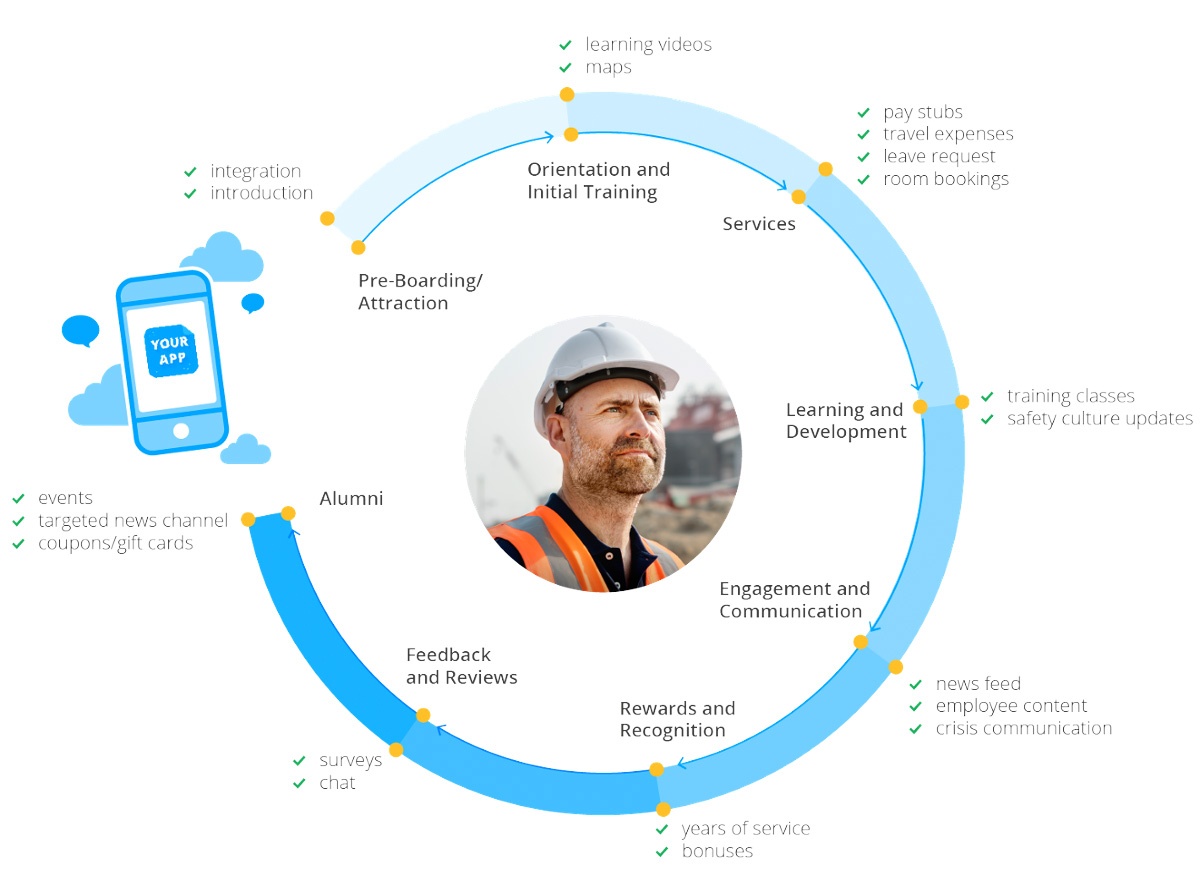 The employee experience is about more than onboarding. It has touchpoints throughout the entire employee lifecycle.
The employee experience is about more than onboarding. It has touchpoints throughout the entire employee lifecycle.
EX management has touchpoints throughout the entire employee lifecycle.
Within an EX framework, internal communications plays a vital role, collaborating with other departments, including IT, finance, and even facilities management. Together, they develop engagement strategies and apply design thinking to the creation of compelling and consistent culture-building programs.
Successful EX management covers a wide array of touchpoints and helps employees find meaning and purpose in the work they do. Above all, it attempts to align the values of individual employees with those of their respective companies.
As a result, recruitment strategies and onboarding processes are just the beginning of the EX management. They mark the start of ongoing learning and development initiatives, communication efforts aimed at increased engagement, meaningful recognition and rewards programs, and a positive culture of feedback and action.
2. Establishing and maintaining workplace culture
I would advise leaders to go about defining their culture. Do so from the heart and think about it in the context of the promise to the customer. Think about how this translates to your employees, and what kind of work environment, ways of working, and behaviors will foster the success of the business through your employees.”
Mark Levy, Employee Experience Pioneer
We’ve written elsewhere about the importance of finding and articulating a core purpose for your company. Above all, putting purpose into practice and establishing ways to bring it to life is what culture is all about. Therefore, it’s a crucial responsibility for EX managers.
Research by Deloitte, shows that 94% of executives and 88% of employees believe that a distinct corporate culture is important to organizational success. And there are more numbers to prove the power of company culture in regard to employee engagement.

For many EX leaders, their first priority is to define the culture of their organization. This process begins by identifying a company’s mission, vision, and values.
Mission: How do you explain to your employees, customers, and partners just what your business does?
Vision: What does your company aspire to become? What’s your plan for getting there?
Values: What do you and your employees believe, and how are these beliefs put into practice?
A positive corporate culture will ensure the employee journey is a positive end-to-end experience.
The next step is for companies to find ways to forge emotional connections between their employees and their brand. In doing so, EX pros work on a range of projects. They use Glassdoor and other employer rating sites to strengthen the employer brand. And they design positive ways to influence the employee lifecycle. This ranges from new hires to veteran employees, and even explores how alumni can advocate for a company’s employer brand.
EX management understands that without alignment at the leadership level, meaningful, lasting change is almost impossible. Consequently, it’s their job to help leaders put their money where their mouths are. They put defined core values into practice consistently throughout the organization, ensuring that these values aren’t dismissed as empty promises.
Such objectives are becoming standard operating procedures for how EX departments can create corporate a culture in which the employee journey is a positive end-to-end experience.
3. Translating data into insight
The role played by workplace analytics technology is drastically transforming HR, with new tools designed to mine the key metrics necessary for building the foundation of the entire employee journey.
People data, which describes people in organizations, personalizes the employee journey and creates targeted experiences that align with individual learning objectives and career paths. In other words, the idea is to match employee interests with organizational goals.
According to an article published by Deloitte, “69% of organizations are building integrated systems to analyze worker-related data, and 17% already have real-time dashboards to crunch the avalanche of numbers in new and useful ways.” These systems include employee experience platforms that provide data-driven reports on employee activity and engagement.
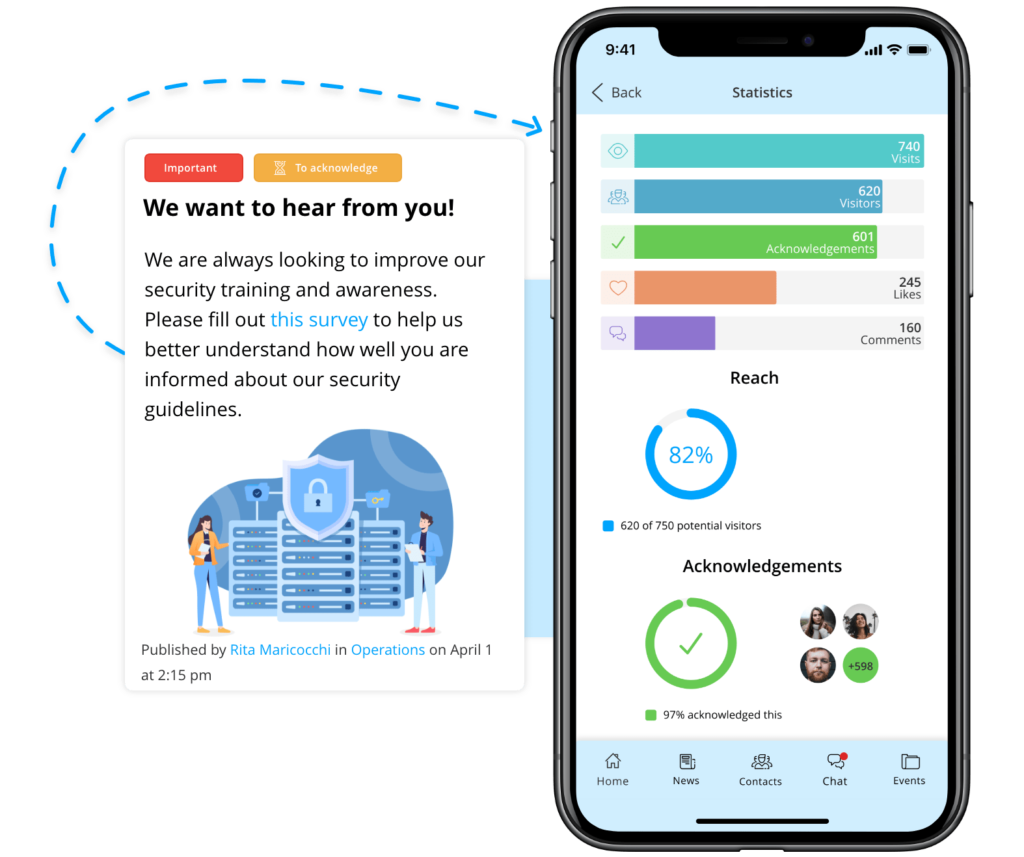 Real-time dashboards of mobile-first intranets can measure statistics such as communications reach.
Real-time dashboards of mobile-first intranets can measure statistics such as communications reach.
All of this information – including data about job progression, career mobility, and performance – allows companies to calculate the lifetime value of talent. Above all, it provides useful insights will can help to optimize an array of touchpoints throughout the employee experience.
Reliable data also helps financial decision-makers understand the ROI of these types of programs and tools, and figuring out which ones are right for you.
By analyzing key metrics and identifying trends that can reveal the current state and ongoing progress of their engagement programs, such data can help organizations drive continuous improvement.
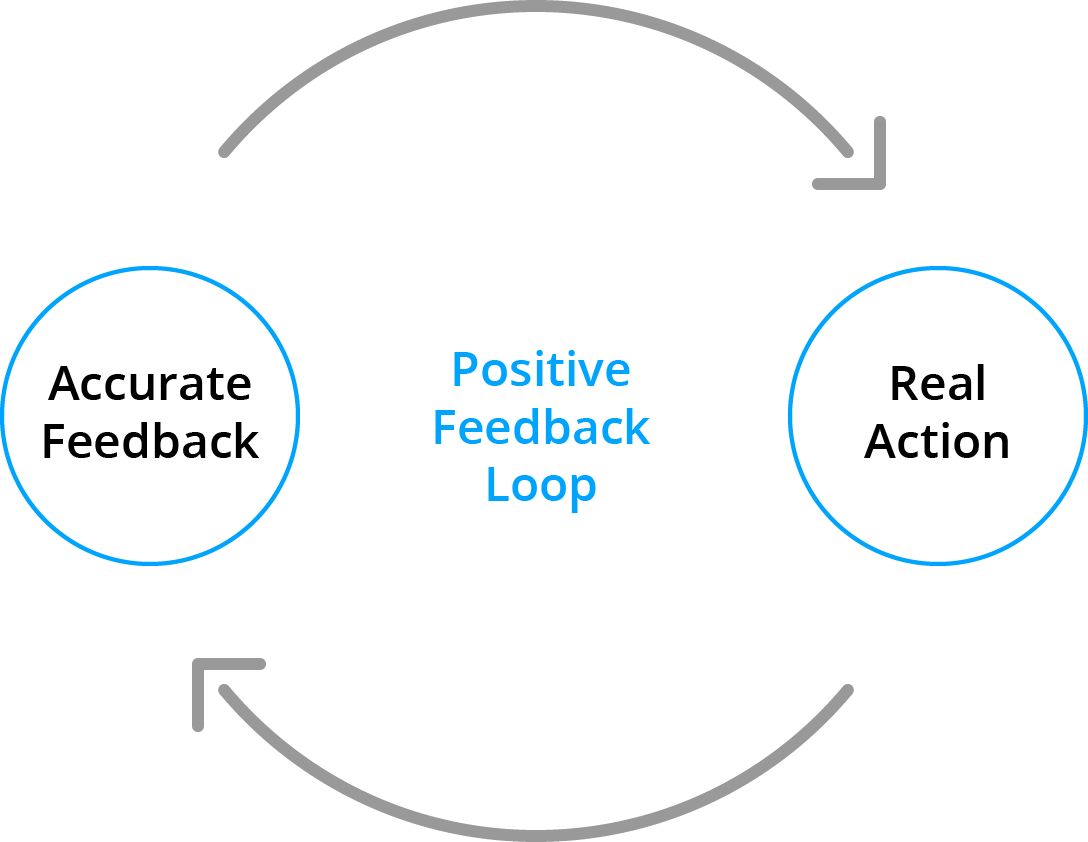 Employee experience management generates real action from accurate feedback.
Employee experience management generates real action from accurate feedback.
The employee experience thrives on feedback. But feedback is only truly valid when it represents voices from throughout your organization-including often forgotten non-desk employees-and is met with a genuine response. Therefore, these two requirements alone can and will make or break the success of any EX initiative.
EX is an ongoing, cyclical process
Businesses need to recognize that employee engagement doesn’t happen via set-and-forget programs. Instead, they need to keep checking in with employees to make sure that initiatives are working, and they need to be responsive to changing sentiment in the organization to stay ahead of the curve.”
Steve Bennetts, employee experience management expert, Qualtrics
Employee experience management software, including employee apps, has become the most effective way to turn anecdotal evidence into hard data that will guide even inexperienced people managers toward ideal engagement strategies for their teams.
“Once they have a clear picture of what motivates and demotivates employees, they can begin to enact meaningful change that gets to the heart of why employees want to work at certain companies,” says Bennetts. “It usually goes beyond gimmicks like free breakfast or casual Fridays.”
5. Reaching a new generation of workers
A major contributor to the rise and relevance of the employee experience is the increasing number of millennials and Generation Z in the workplace. The presence and expectations of these younger workers have made it imperative for forward-thinking organizations to fundamentally redefine their structure and purpose.
Gen Z will make up about 30% of the U.S. workforce by 2030.” The U.S. Bureau of Labor Statistics
Finding people with the ability to manage the shifting values of these younger workers is yet another explanation for the rapid rise in the number of EX professionals.
For EX managers, millennials in particular present the biggest challenge when it comes to creating engagement in the multigenerational workplace. This need to address lackluster engagement numbers will only accelerate with millennials predicted to account for 75% of the global workforce by 2025.
And generational concerns don’t end with engagement. According to Gallup, millennials are also the most likely generation to switch jobs, with six out of ten open to new employment opportunities.
Generation Z expects great communication.
As for Generation Z, which already comprised 20% of the workforce in 2020, they expect communication to be rapid, constant, and available at their fingertips.
Of course the trick of engaging one workplace generation is to do so without alienating up to as many as four others. Every generation, from Boomers to Gen Z, wants access to relevant company news, information, and services, but they want it available in ways that are easy and familiar to them.
There are many communication channels for satisfying different generational preferences. That’s why targeting your workforce with personalized messaging can be such a complex undertaking. Customizable tools such as employee apps and employee experience intranets make this job more manageable.
Ultimately, EX professionals with the ability to effectively navigate the generational waters will be the ones who make the biggest splash with workers who still have a majority of their careers in front of them.
6. Improving the employer brand
A major responsibility of employee experience management is communicating their employer brand. Therefore, it’s the job of EX professionals to think strategically about how to promote their brand internally and externally, and to understand how to influence attitudes about it.
Culture and experience are subjective perceptions of how an organization functions and interacts on the whole. These perceptions are communicated most effectively through your employees. When they’re excited about a new career opportunity, they’re likely to tell family and friends, both in person and on social media. The same goes for an upsetting interaction with their colleagues or supervisor.
It’s this type of authentic information that job seekers trust most when deciding if they’re a good match for a potential employer. Employee Experience professionals understand that today’s talent wants real stories that reflect their expectations of an ideal employer.

By inspiring their own employees with positive experiences that make for compelling stories, EX pros can create genuine advocates in the workplace. After that, these people can assist in the job of attracting the future talent necessary for long-term business success.
Your employer brand is the best way to attract and retain the people who make your organization a success.
Ultimately, the most powerful voice of a strong and compelling employer brand is that of your employees. They are the most believable voices you have for sharing the authentic employee experiences that reinforce your culture and brand.
EX pros know that your employer brand is the best way to attract and retain the people who make your organization a success. They understand that your brand isn’t something you can dictate to the market. Instead, it is a conclusion the market will reach based on its interactions with your organization and its employees.
The challenge for many companies is that they often overestimate the strength of their employer brand. For instance, EX professionals must be adept at getting an accurate picture of how people view their organization. And they need to understand how that perception shapes the opinion of the world beyond its doors.
Here are some of the ways to do that:
Use social media listening tools to monitor online mentions of your organization.
Read employee reviews from past and current employees on Glassdoor, etc.
Monitor the content on which employees are commenting, liking, or sharing on sites like Facebook, LinkedIn, or in their employee app.
Survey staff for feedback regarding their current employee experience.
Conclusion: Employee Experience Management puts people first
Creating a compelling employee experience requires a deep understanding of the needs and expectations of people at work.
EX management operates beyond individual organizational silos. It has a cross-functional role working with multiple departments. These include Human Resources, Operations, Marketing, IT, software engineering, data science, and Internal Comms.
The all-encompassing vision of EX management presents an opportunity to reach out to employees in other disciplines. Finding suitable employee champions and ambassadors is more than a matter of re-skilling current HR professionals. Talented Employee Experience managers don’t strictly come from the world of HR.
 Talented Employee Experience managers don’t strictly come from the world of HR.
Talented Employee Experience managers don’t strictly come from the world of HR.
EX professionals understand that first impressions are lasting ones. From day one, they focus on creating compelling employee experiences and seamless processes that can offer aid and guidance. Their work ensures that new hires are more likely to stay and remain engaged throughout every stage of the employee journey.
EX pros know that research shows that new employees with tenures of less than two years often leave because of frustration with unproductive, poorly optimized work processes. As a result, it is greatly aided by the latest consumer-grade digital technologies that are revolutionizing work for the better.
EX management has been created to address multiple objectives. It is broadening the function of HR, reaching across departments to deliver an employee experience that’s human-centered, positive, and communication-focused.








